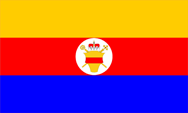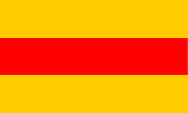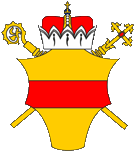Münster |
|
|
|
| Übersicht – Contents: | |
Münster |
|
|
|
| Übersicht – Contents: | |
Flaggen – Flags: |
|
 |
ca.1770–1803, Flagge Fürstbistum Münster – flag of the prince-bishopric of Muenster, Quelle/Source: Wikipedia (D), World Statesmen |
 |
Flagge Bistum Münster – flag of the Diocese of Muenster, Quelle/Source: Bischöfliches Priesterseminar Borromaeum |
|
|
|
Bedeutung/Ursprung der Flagge – Meaning/Origin of the Flag: |
|
| Die Flagge des Fürstbistums zeigt drei horizontale Streifen in Gold, Rot und Blau und in der Mitte des roten Streifens eine Weiße Scheibe mit dem Wappen in der Mitte. Sie wurde auch auf See verwendet. | The flag of the prince-bishopric shows three horizontal stripes in gold, red and blue and in the middle of the red stripe a white disc with the coat of arms in the middle. It was also used at sea. |
| Die Flagge des Bistums Münster ist eine Wappenflagge. Sie zeigt die Farben des Wappenschildes des Bistums Münster, einen goldenen Schild mit einem roten Balken in der Mitte. Sie wird heute noch an wichtigen Liegenschaften des Bistums gehisst. | The flag of the Diocese of Münster is a scutcheon-flag. It shows the colors of the blazon of the Diocese of Münster, a golden shield with a red bar in the middle. It is until today in use and it is still hoisted at important estates of the diocese. |
| Quelle/Source: Wikipedia (D), World Statesmen, Volker Preuß | |
Wappen – Coat of Arms: |
|
 |
Wappen des Fürstbistum Münster
– Coat of arms of the prince-bishopric of Muenster, Quelle/Source: Wikipedia (D), World Statesmen |
Bedeutung/Ursprung des Wappens – Meaning/Origin of the Coat of Arms: |
|
| Das Wappen ist ein übliches geistliches Wappen. Bemerkenswert ist lediglich der Fürstenhut oberhalb des Wappens. Nachdem das Bistum seine weltliche Souveränität verloren hatte und ein rein geistliches Gebiet geworden war, wurde der Fürstenhut durch eine Bischofsmütze (Mitra) ersetzt. |
The coat of arms is a common ecclesiastic coat of
arms. Only the prince's hat above the coat of arms is remarkable. After the diocese had lost its secular sovereignty and had become a purely ecclesiastical area, the prince's hat was replaced by a bishop's hat (mitra). |
| Quelle/Source: Wikipedia (D), World Statesmen, Volker Preuß | |
|
|
|
| Landkarte – Map: |
|
|
|
Zahlen und Fakten – Numbers and Facts: |
|
|
|
|
|
Geschichte: |
|
Antike
· Besiedlung durch germanische Stämme 12 v.Chr. · das Gebiet wird durch Römische Truppen unter Drusus erobert 9 n.Chr. · germanischer Aufstand, die Römer ziehen sich hinter den Rhein zurück ca. 250 · in der Gegend siedeln Franken ca. 300 · in der Gegend siedeln Sachsen ca. 6.Jhd. · sächsische Siedlung Mimigernaford 793 · Gründung eine Klosters durch den friesischen Missionar Liudger 805 · Liudger wird zum ersten Bischof von Münster ernannt 9.–11. Jhd. · Münster gehört zum Herzogtum Sachsen 1170 · Stadtrecht 12./13. Jhd. · das Bistum Münster entwickelt sich zu einem geistlichen Fürstentum mit eingenen Hoheitsrechten (Fürstbistum) 14./15. Jhd. · die Stadt Münster ist Mitglied des Hansebundes 1534–1535 · Zentrum der Täuferbewegung 1648 · Westfälischer Friede von Münster und Osnabrück, Ende des Dreißigjährigen Krieges 1661 · Münster strebt nach dem Status als "Freie Reichsstadt", wird jedoch vom Fürstbischof belagert und bekommt zweitweilig alle Rechte abgesprochen 1801 · Tod des letzten Fürstbischofs 1802 · Preußen besetzt das Gebiet um einen Anschluss der Region an den dem Napoléonischen Frankreich freundlich gesinnten Rheinbund zu verhindern 1803–1806 · als Erbfürstentum Münster unter Oberhoheit von Preußen 1806 · Truppen Napoléons besetzen Münster, das Land wird teilweise direkt an Frankreich und teilweise an das Großherzogtum Berg angeschlossen 1813 · preußische und russische Truppen Befreien die Stadt von den Franzosen 1815 · Wiener Kongress, die Region kommt an das Königreich Preußen und wird der Provinz Westfalen angeschlossen, Hauptstadt der Provinz ist Münster |
History: |
|
antiquity
· settlement by Germanic tribes 12 B.C. · the region was conquered by Roman forces under Drusus 9 A.D. · Germanic revolt, the Romans withdraw behind the Rhine River ca. 250 · in the area settle Franks ca. 300 · in the area settle Saxons ca. 6th century · Saxon settlement of Mimigernaford 793 · foundation of a monastery by the Frisian missionary Liudger 805 · Liudger appointed first bishop of Muenster 9th–11th century · Münster belongs to the Duchy of Saxony 1170 · city law 12th–13th century · the Diocese of Muenster, is becoming a clerical principality with own sovereign rights (Bishopric) 14th–15th century · the city of Muenster is a member of the Hanseatic League 1534–1535 · centre of the Anabaptist movement 1648 · Westphalian Peace of Muenster and Osnabrück, the end of the Thirty Years War 1661 · Muenster strives for the status of "free city" but is besieged by the Prince Bishop and gets all the rights temporarily denied 1801 · death of the last Prince Bishop 1802 · Prussia occupies the area around to prevent a port of the region to the Napoléonic France friendly minded Confederation of the Rhine 1803–1806 · as Hereditary-Principality of Muenster under sovereignty of Prussia 1806 · troops of Napoléon occupy Muenster, the country is partly connected directly to France and partly to the Grand Duchy of Berg 1813 · Prussian and Russian troops free the city from the French 1815 · Congress of Vienna, the region comes to the Kingdom of Prussia and becomes connected to the province of Westphalia, capital of the province is Muenster |
| Quelle/Source: Wikipedia (D), Atlas zur Geschichte, RetroBib Retrobibliothek, Discovery '97 |
Ursprung des Landesnamens – Origin of the Country's Name: |
|
| Der ursprüngliche Name der Siedlung, bei der im Jahre 793 der friesische Missionar Liudger ein Kloster gründete, war Mimigernaford. Das lateinische Wort für Kloster (monasterium), war schließlich prägend für "Münster", dem modernen Namen des Ortes und Bistums. | The original name of the settlement was Mimigernaford, when the Frisian missionary Liudger founded in 793 a monastery there. The Latin word for monastery (monasterium), was finally formative for "Muenster" (Muenster), the modern name of the town and diocese. |
| Quelle/Source: Wikipedia (D) | |